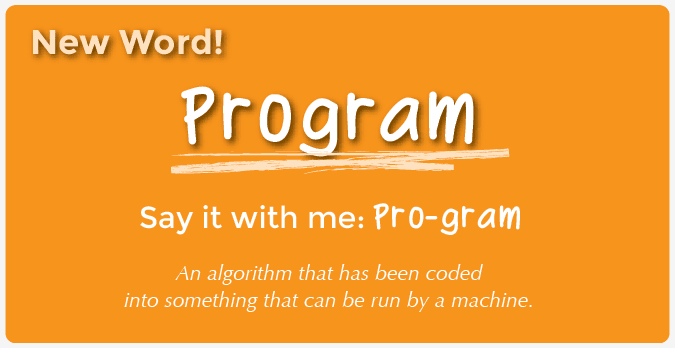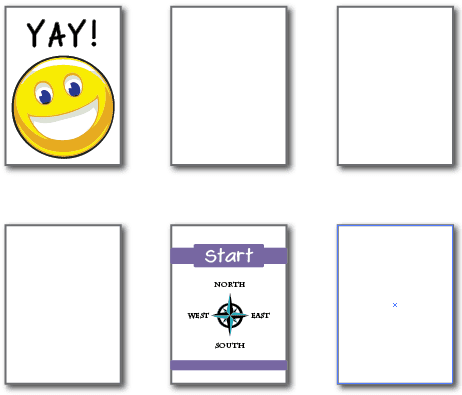Lesson Overview
This lesson will help students realize that in order to give clear instructions, they need a common language. Students will practice controlling one another using a simple combination of hand gestures. Once they understand the language, they will begin to "program" one another by giving multiple instructions in advance.
Teaching Summary
Getting Started - 15 minutes
1) Review
2) Vocabulary
3) Let's Control Ourselves
Activity: Move It, Move It - 20 minutes
4) Move It, Move It: Multi-Step Adventure
Wrap-up - 5 minutes
5) Flash Chat - What did we learn?
6) Vocab Shmocab
Assessment - 10 minutes
Lesson Objectives
Students will:
- Recognize situations where they can create programs to complete tasks
- Predict moves necessary to get teammate from start to finish
- Convert movements into symbolic instructions
- Relate algorithms as programs to teammates
Teaching Guide
Materials, Resources and Prep
For the Student
- Maps and Key from Move It, Move It: Multi-Step Adventure
- Assessment Worksheet: Move the Flurbs 2
- Scissors
- Glue
For the Teacher
- Lesson Video
- Teacher Lesson Guide
- Print one Move It, Move It: Multi-Step Adventure activity pack on Cardstock for each group
- Print Assessment Worksheet: Move the Flurbs 2 for each student
Getting Started (15 min)
1) Review
This is a great time to review the last lesson that you went through with your class. You can do this as one large group or have students discuss with an elbow partner.
Here are some questions that you can ask in review:
What did we do last time?
What do you wish we had had a chance to do?
Did you think of any questions after the lesson that you want to ask?
What was your favorite part of the last lesson?
Lesson Tip
Finishing the review by asking about the students' favorite things helps to leave a positive impression of the previous exercise, increasing excitement for the activity that you are about to introduce.
2) Vocabulary
This lesson has one new and important word:

Program - Say it with me: Pro-gram
An algorithm that has been coded into something that can be run by a machine.
3) Let's Control Ourselves
- Ask your students if they remember helping you draw a smiley face last time.
- Review the instructions by drawing as they guide you one step at a time.
- Review the instructions by drawing as they guide you one step at a time.
- Let them know that you're going to make a small change.
- Now, I want you to give me two instructions at a time before I move my pen.
- Now, I want you to give me two instructions at a time before I move my pen.
- Can you do it again, but give me three instructions at a time?
- When you give me multiple instructions at a time, you're providing me with an "algorithm" to draw each piece of the smiley face.
- Now, suppose we were to have a secret "code" for each of those instructions. For example, "Draw an Eye" could look like this: (make a large circle with your hands). If we had special codes for each of those steps, then our algorithm would become a program.
- We're going to play a game that allows us to program each other...and you'll do it all with your arms!
Lesson Tip
Feel free to do an example map with the students as a class before breaking them into groups or even describing the rules (beyond how to react to each of the arm gestures). Learning through play is often more effective than spouting off all of the rules at this age.
Activity: (20 min)
4) Move It, Move It: Multi-Step Adventure
- This worksheet helps teach students how to think ahead in multiple steps, as they plan a short route from their friend's start location to the hidden smiley face, up to three steps away.
- Print out an activity packet for every group (ideally 2 to 4 students) and cut the Map Cards apart.
- Explain the rules to the class, making sure to emphasise the new word "program."
Directions for Class:
- Decide who will be the Walking Machine and who will be the Controller.
- Have the Controller set up a grid on the floor made up of pieces of paper as shown on one of the Move It Maps, except with the smiley face upside down, facing the ground.
- The Walking Machine will start by standing on the page with the compass rose.
- The Controller will then lead the Walking Machine step-by-step through the paper maze that they created, using the provided arm signals.
- When the Controller gives the signal to “STOP,” the Walking Machine will flip over the page that they are on. If that page is a smiley face, then the maze was a success!
- The Controller (and anyone else in the group who is not the Walking Machine) can set up a map made of paper, based on one of the Move It Map cards.

Remember that the smiley face map page should actually be set facing the ground, so that the Walking Machine cannot easily tell where their final location is.
The Walking Machine begins by standing on the piece of paper imprinted with the compass rose.

Lesson Tip
Here are some useful links in case your class hasn't yet talked about the compass rose and cardinal directions:
These topics will be important in the online lessons that follow, so taking an extra couple of minutes to be sure that your students correlate North with Up, South with Down, East with Right, and West with Left will continue to be helpful hereafter.
The Controller uses arm movements to guide the Walking Machine. Encourage the Controller to be facing the same direction as the Walking Machine to avoid having them get confused by "East is Right" and "West is Left."
-
Controllers should start by giving one direction at a time, allowing the Walking Machine to take a step before they move on to the next direction.
- Halfway into the activity, you can encourage your students to Control with two instructions before they allow the Walking Machine to take a step, and then three.
- Ideally, by the time the lesson is complete, the students will relay the entire "program" to the Walking Machine before the Walking Machine even takes their first step.

Lesson Tip
Note that the rules are not the most important thing here. Feel free to clarify if the students have questions, but if the students are playing a bit differently than described, you don't need to hold them to the letter of the game. The crucial bit is that they are moving from immediate instructions to giving two or three instructions before the Walking Machine moves.
Wrap-up (5 min)
5) Flash Chat: What did we learn?
- In the game we just played, who do you suppose was more like a programmer, and who was more like a computer?
- What were the four directions on the compass rose?
- What tricks can we use to remember North, South, East and West?
- How could we have given instructions without using our arms?
- What was your favorite part about that game?
6) Vocab Shmocab
- Which one of these definitions did we learn a word for today?
"The fluffy feathers of a baby bird"
"The circuit board that controls a robot"
"An algorithm that has been coded into something that can be run by a machine"...and what is the word that we learned?
Assessment (10 min)
7) Move the Flurbs 2
- Hand out the worksheet titled "Move the Flurbs 2" and allow students to complete the activity independently after the instructions have been well explained.
- This should feel familiar, thanks to the previous two activities.
Extended Learning
Use these activities to enhance student learning. They can be used as outside of class activities or other enrichment.
X's and O's
- Draw a tic-tac-toe board for the class.
- Place a single X and a single O somewhere on the board.
- Ask the class if they can get the X to the O using arm gestures as a class.
X's, O's, and Arrows
- Similar to the activity above, but have the students write their programs in advance using arrows instead of hand gestures.
- This can be done in groups.
- Groups can share their solutions for the class.
Connections and Background Information
ISTE Standards (formerly NETS)
- 1.c - Use models and simulation to explore complex systems and issues.
- 2.d - Contribute to project teams to solve problems.
- 4.b - Plan and manage activities to develop a solution or complete a project.
- 6.a - Understand and use technology systems.
CSTA K-12 Computer Science Standards:
- CPP.L1:3-04 - Construct a set of statements to be acted out to accomplish a simple task.
- CPP.L1:6-05. Construct a program as a set of step-by-step instructions to be acted out.
- CT.L1:6-01 - Understand and use the basic steps in algorithmic problem-solving.
- CT.L1:6-02 - Develop a simple understanding of an algorithm using computer-free exercises.
- CT.L2-03. Define an algorithm as a sequence of instructions that can be processed by a computer.
- CT.L2-06. Describe and analyze a sequence of instructions being followed.
Common Core Mathematical Practices
- 1. Make sense of problems and persevere in solving them.
- 2. Reason abstractly and quantitatively.
- 6. Attend to precision.
- 7. Look for and make use of structure.
- 8. Look for and express regularity in repeated reasoning.
Common Core Math Standards
- K.G.A.1 - Describe objects in the environment using names of shapes, and describe the relative positions of these objects using terms such as above, below, beside, in front of, behind, and next to.
- K.CC.4 - Understand the relationship between numbers and quantities; connect counting to cardinality.
Common Core Language Arts Standards
- SL.K.1 - Participate in collaborative conversations with diverse partners about kindergarten topics and texts with peers and adults in small and larger groups.
- SL.K.2 - Confirm understanding of a text read aloud or information presented orally or through other media by asking and answering questions about key details and requesting clarification if something is not understood.
- L.K.6 - Use words and phrases acquired through conversations, reading and being read to, and responding to texts.
- SL.1.1 - Participate in collaborative conversations with diverse partners about grade 1 topics and texts with peers and adults in small and larger groups
- SL.1.2 - Ask and answer questions about key details in a text read aloud or information presented orally or through other media.
- L.1.6 - Use words and phrases acquired through conversations, reading and being read to, and responding to texts, including using frequently occurring conjunctions to signal simple relationships.
- SL.2.1 - Participate in collaborative conversations with diverse partners about grade 2 topics and texts with peers and adults in small and larger groups.
- SL.2.2 - Recount or describe key ideas or details from a text read aloud or information presented orally or through other media.
- L.2.6 - Use words and phrases acquired through conversations, reading and being read to, and responding to texts, including using adjectives and adverbs to describe.

